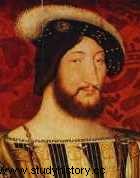 Son of Charles d'Angoulême and Louise de Savoie, François I succeeded his cousin Louis XII in 1515, whose daughter Claude he married. With the victory of Marignan, François I reconquers the Milanese. The power of Charles V and the threat of the encirclement of the kingdom by the possessions of his rival push him to engage in hostilities against the emperor after having vainly sought the support of Henry VIII of England. Having become a widower, he remarried Éléonore de Habsbourg, the sister of Charles V. François I is undoubtedly one of the builders of the modern state in France. He reorganized the finances of the State and reformed justice by the ordinance of Villers-Cotterêts (1539), which notably imposed the drafting in French of legal acts. By the Concordat of Bologna (1516), he ensured the appointment of archbishops, bishops and abbots of the kingdom. The King also favored Renaissance art, which flourished in the construction and decoration of royal residences (Blois, Chambord, Fontainebleau), where François I attracted and employed Italian artists (Leonardo da Vinci, the Rosso , Primaticcio). He encouraged translations by humanists and founded the future Collège de France. On his death in 1547, his son Henry II succeeded him.
Son of Charles d'Angoulême and Louise de Savoie, François I succeeded his cousin Louis XII in 1515, whose daughter Claude he married. With the victory of Marignan, François I reconquers the Milanese. The power of Charles V and the threat of the encirclement of the kingdom by the possessions of his rival push him to engage in hostilities against the emperor after having vainly sought the support of Henry VIII of England. Having become a widower, he remarried Éléonore de Habsbourg, the sister of Charles V. François I is undoubtedly one of the builders of the modern state in France. He reorganized the finances of the State and reformed justice by the ordinance of Villers-Cotterêts (1539), which notably imposed the drafting in French of legal acts. By the Concordat of Bologna (1516), he ensured the appointment of archbishops, bishops and abbots of the kingdom. The King also favored Renaissance art, which flourished in the construction and decoration of royal residences (Blois, Chambord, Fontainebleau), where François I attracted and employed Italian artists (Leonardo da Vinci, the Rosso , Primaticcio). He encouraged translations by humanists and founded the future Collège de France. On his death in 1547, his son Henry II succeeded him.
Louis XII Henri II
See the article dedicated to the character
